Science
Homily on the Third Sunday of Great Lent. On Carrying Your Cross
13. March 2018 - 9:27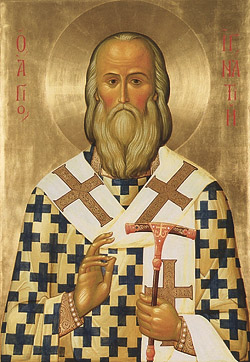 Whosoever will come after me, let him deny himself, and take up his cross, and follow me (Mk. 8:34), said the Lord to his disciples, calling them unto Him, as we heard today in the Gospels.
Whosoever will come after me, let him deny himself, and take up his cross, and follow me (Mk. 8:34), said the Lord to his disciples, calling them unto Him, as we heard today in the Gospels.
Dear brothers and sisters! We too are disciples of our Lord Jesus Christ, because we are Christians. We too are called unto the Lord, to this holy temple, to hear His teaching. We stand before the face of the Lord. His gaze is directed at us. Our souls are laid bare before Him; our secret thoughts and hidden feelings are open to Him. He sees all of our intentions; He sees the truth, and the sins we have committed from our youth; He sees our whole life, past and future; even what we have not yet done is already written in His book.[1] He knows the hour of our passing into immeasurable eternity, and gives us His all-holy commandment for our salvation: "Whosoever will come after me, let him deny himself, and take up his cross, and follow me."
First and second finding of the Honorable Head of the Holy Glorious Prophet, Forerunner, and Baptist of the Lord, John
11. March 2018 - 14:04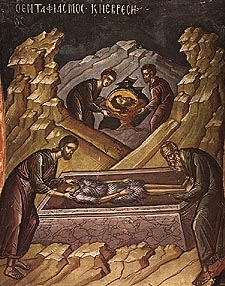 After the Beheading of the Holy Prophet, Forerunner and Baptist John (August 29), his body was buried by disciples in the Samarian city of Sebaste, and his venerable head was hidden by Herodias in an unclean place. Saint Joanna (June 27), the wife of King Herod’s steward Chuza (Luke 8:3), secretly took the holy head and placed it into a vessel and buried it on the Mount of Olives in one of Herod’s properties.
After the Beheading of the Holy Prophet, Forerunner and Baptist John (August 29), his body was buried by disciples in the Samarian city of Sebaste, and his venerable head was hidden by Herodias in an unclean place. Saint Joanna (June 27), the wife of King Herod’s steward Chuza (Luke 8:3), secretly took the holy head and placed it into a vessel and buried it on the Mount of Olives in one of Herod’s properties.
After many years, this property passed into the possession of a government official who became a monk with the name of Innocent. He built a church and a cell there. When they started to dig the foundation, the vessel with the venerable head of John the Baptist was uncovered. Innocent recognized its great holiness from the signs of grace emanating from it. Thus occurred the First Finding of the Head. Innocent preserved it with great piety, but fearful that the holy relic might be abused by unbelievers, before his own death he again hid it in that same place, where it was found. Upon his death the church fell into ruin and was destroyed.
First and second finding of the Honorable Head of the Holy Glorious Prophet, Forerunner, and Baptist of the Lord, John
9. March 2018 - 9:58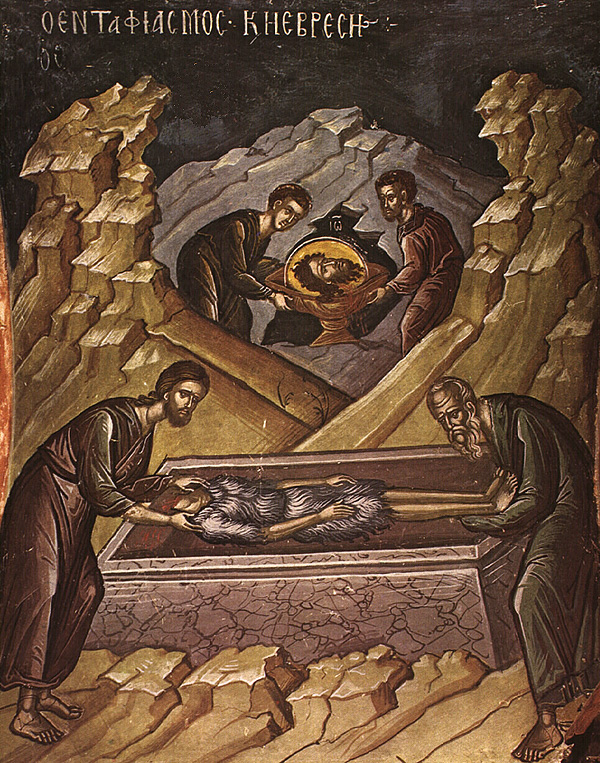 After the Beheading of the Holy Prophet, Forerunner and Baptist John (August 29), his body was buried by disciples in the Samarian city of Sebaste, and his venerable head was hidden by Herodias in an unclean place. Saint Joanna (June 27), the wife of King Herod’s steward Chuza (Luke 8:3), secretly took the holy head and placed it into a vessel and buried it on the Mount of Olives in one of Herod’s properties.
After the Beheading of the Holy Prophet, Forerunner and Baptist John (August 29), his body was buried by disciples in the Samarian city of Sebaste, and his venerable head was hidden by Herodias in an unclean place. Saint Joanna (June 27), the wife of King Herod’s steward Chuza (Luke 8:3), secretly took the holy head and placed it into a vessel and buried it on the Mount of Olives in one of Herod’s properties.
After many years, this property passed into the possession of a government official who became a monk with the name of Innocent. He built a church and a cell there. When they started to dig the foundation, the vessel with the venerable head of John the Baptist was uncovered. Innocent recognized its great holiness from the signs of grace emanating from it. Thus occurred the First Finding of the Head. Innocent preserved it with great piety, but fearful that the holy relic might be abused by unbelievers, before his own death he again hid it in that same place, where it was found. Upon his death the church fell into ruin and was destroyed.
Hieromartyr Polycarp the Bishop of Smyrna
8. March 2018 - 16:34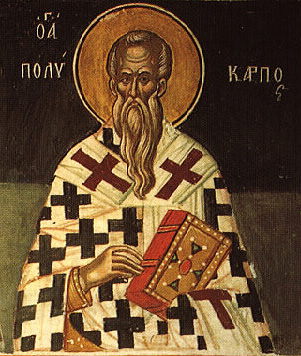 Saint Polycarp, Bishop of Smyrna, who was “fruitful in every good work” (Col. 1:10), was born in the first century, and lived in Smyrna in Asia Minor.
Saint Polycarp, Bishop of Smyrna, who was “fruitful in every good work” (Col. 1:10), was born in the first century, and lived in Smyrna in Asia Minor.
He was orphaned at an early age, but at the direction of an angel, he was raised by the pious widow Kallista. After the death of his adoptive mother, Polycarp gave away his possessions and began to lead a chaste life, caring for the sick and the infirm. He was very fond of and close to Saint Bucolus, Bishop of Smyrna (February 6). He ordained Polycarp as deacon, entrusting to him to preach the Word of God in church. He also ordained him to the holy priesthood.
Sermon by Newly-Canonized Serbian Bishop Mardarije (Uskokovic) on the Second Sunday of Great Lent, Delivered at the Church of Saint Olga Orphanage in Kishinev.
4. March 2018 - 2:20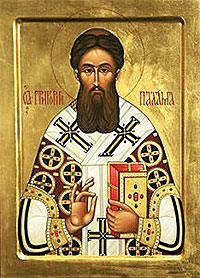 My dear children. I visited your wealthy and valuable library, I saw very many interesting and beneficial books on various topics and saw you often reading these fine tomes. But to my great sorrow and disappointment, I did not see the most important of all books. I looked throughout the library and could not find a single Bible. You are not to blame for this, nor are your teachers, it is the spirit of the time that is to blame, contemporary society. This wonderful book is very hard to find even in the most eminent homes. It is considered to be an old, boring book whose days have passed. Oh how cruelly are people mistaken! There is no book more valuable than the Bible. There was not and will not ever be another book which can replace the Bible.
My dear children. I visited your wealthy and valuable library, I saw very many interesting and beneficial books on various topics and saw you often reading these fine tomes. But to my great sorrow and disappointment, I did not see the most important of all books. I looked throughout the library and could not find a single Bible. You are not to blame for this, nor are your teachers, it is the spirit of the time that is to blame, contemporary society. This wonderful book is very hard to find even in the most eminent homes. It is considered to be an old, boring book whose days have passed. Oh how cruelly are people mistaken! There is no book more valuable than the Bible. There was not and will not ever be another book which can replace the Bible.
Synodikon of Orthodoxy
25. February 2018 - 2:16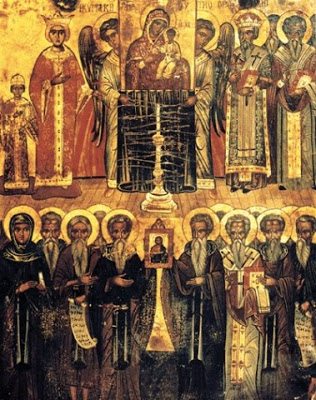 The text of the Synodikon of Orthodoxy has been much altered over the centuries, chiefly by the addition of material and names that postdate the Restoration of the Icons in 843. This is the case with the text that is printed in the current Triodia. Some of the more zealous contemporary Orthodox even include condemnations of such things as the ‘pan-heresy of Ecumenism‘. It is probably impossible to reconstruct the original text exactly. However the British Library possesses a manuscript, (BL. Additional 28816) written in 1110 or 1111 by a monk Andrew of the monastery of Oleni in Moraea, which may give some idea of the scope and contents of the original. In the opinion of Jean Gouillard, the editor of the critical edition of the Synodikon, ‘the London manuscript is certainly one of the best witnesses to the primitive and purely Constantinopolitan form of the Synodikon’. The manuscript was unknown to him when he prepared his edition and has in consequence been generally neglected.
The text of the Synodikon of Orthodoxy has been much altered over the centuries, chiefly by the addition of material and names that postdate the Restoration of the Icons in 843. This is the case with the text that is printed in the current Triodia. Some of the more zealous contemporary Orthodox even include condemnations of such things as the ‘pan-heresy of Ecumenism‘. It is probably impossible to reconstruct the original text exactly. However the British Library possesses a manuscript, (BL. Additional 28816) written in 1110 or 1111 by a monk Andrew of the monastery of Oleni in Moraea, which may give some idea of the scope and contents of the original. In the opinion of Jean Gouillard, the editor of the critical edition of the Synodikon, ‘the London manuscript is certainly one of the best witnesses to the primitive and purely Constantinopolitan form of the Synodikon’. The manuscript was unknown to him when he prepared his edition and has in consequence been generally neglected.

